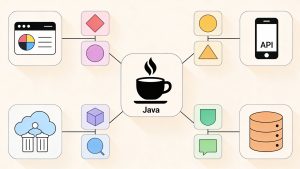In the ever-evolving world of web development, frontend architecture patterns play a crucial role in structuring and organizing the implementation of software products. These patterns serve as reusable guidelines that help developers create efficient, scalable, and maintainable user interfaces. As the complexity of web applications continues to grow, choosing the right frontend architecture has become increasingly important for development teams.
This comprehensive guide explores the most popular frontend architecture patterns used in modern software development, discussing their strengths, weaknesses, and practical applications. By understanding these patterns, developers can make informed decisions when selecting the optimal architecture for their projects, ultimately leading to more sustainable and high-performance software products.
Monolithic Architecture
Monolithic architecture is characterized by hosting the entire frontend application, including interfaces, resources, and dependency modules, within a single project codebase. This pattern typically utilizes the Model-View-Controller (MVC) approach alongside components, widgets, and layout fragments to organize code.
Strengths:
- Simple codebase structure for small projects
- Beginner-friendly development environment
- Simplified debugging and testing process
- Streamlined deployment and pre-deployment workflows
- Fast initial project handover and reduced development costs
Weaknesses:
- Increased codebase complexity as the project grows
- Limited scalability due to tightly coupled codebase
- Potential collaboration limitations and code integration challenges
- Longer deployment times and full app restarts
Use Cases:
Monolithic frontend architecture is well-suited for simpler software frontends maintained by small to medium-sized development teams. It is particularly beneficial when faster initial project delivery is prioritized over long-term scalability and future codebase growth prevention.
Modular Architecture
Modular architecture decomposes the codebase into separate, maintainable, and installable modules. This pattern involves splitting the primary app code into sub-modules based on functionality, allowing for isolated development, testing, and deployment of individual components.
Strengths:
- Reduced main codebase complexity and improved maintainability
- Enhanced collaboration through parallel development
- Adherence to the plugin-core architecture pattern
- Distributed test and deployment scripts
- Improved unit test arrangement
Weaknesses:
- Increased complexity with a growing number of submodules
- Steeper learning curve for beginners
- Difficulty in viewing the entire project codebase from a single repository
- Slower deployments and full app restarts
Use Cases:
Modular architecture is an effective strategy for improving maintainability and collaboration in large monolithic codebases without requiring expensive rewrites. It is ideal for development teams willing to invest initial time for future collaboration and maintainability benefits.
Component-Based Architecture
Component-based architecture focuses on using reusable components to construct the software product interface. Components encapsulate templates, UI logic, and styles, allowing developers to divide large UIs into functional and relevant units.
Strengths:
- Improved maintainability, readability, and developer productivity
- Easy decomposition of app layouts into atomic elements
- Aggregation of template, logic, and styles into atomic segments
- Consistent UI/UX through reusable components
Weaknesses:
- Potential challenges in handling application state with large component trees
- Need for additional libraries to solve state management issues
- Time investment required for implementing mock services in unit tests
- Learning curve for mastering component-based architecture and best practices
Use Cases:
Component-based architecture is the foundation of popular frontend libraries like React, Vue, and Angular. It is ideal for developers seeking code reusability, render-tree-like code structure, and component-based unit testing capabilities.
Microfrontend Architecture
Microfrontend architecture divides the app frontend into isolated, maintainable frontend projects called microfrontends. This pattern involves creating a host app responsible for loading microfrontends and managing their execution lifecycles.
Strengths:
- Improved scalability and maintainability through reusable microfrontends
- On-demand loading of frontend segments for optimal performance
- Easy assignment of frontend segments to teams based on domain or functionality
- Silent deployments without restarting the host app
Weaknesses:
- Increased complexity in product architecture and deployment workflows
- Slower initial product development and feature deliveries
- Challenging learning curve for some frontend developers
- Need for standardization to preserve UI/UX consistency
Use Cases:
Microfrontend architecture is recommended for complex projects maintained by large development teams. It provides solutions for maintainability, scalability, and deployment issues in large-scale monolithic frontend projects.
Flux Architecture
Introduced by Meta (formerly Facebook), Flux architecture offers a solution for managing application state and data flow in complex component-based apps. It introduces a unidirectional data flow and centralized state stores.
Strengths:
- Reduced state management and data flow complexity
- Improved maintainability and developer productivity
- Predictable state and clear code division
- Easy implementation of replayable application state and logging features
- Simplified debugging experience
Weaknesses:
- Steeper learning curve for developers unfamiliar with the Flux concept
- Potential complication of simple projects
- Introduction of more boilerplate code
- Increased overall codebase engineering complexity
Use Cases:
Flux architecture is suitable for medium-sized or large component-based apps with complex, frequently updated states. It is particularly beneficial for applications requiring robust state management and predictable data flow.
Hybrid/Mixed Architecture
In practice, many developers opt for hybrid or mixed architecture patterns, combining multiple approaches to meet specific project requirements. This flexibility allows teams to leverage the strengths of different patterns while mitigating their weaknesses.
Examples of Hybrid Architectures:
- Combining monolithic and component-based architectures for website development
- Utilizing modular, component-based, and Flux architectures for medium-sized e-commerce apps
- Implementing component-based and Flux patterns within a microfrontend host app for complex enterprise systems
By carefully considering project complexity, scalability requirements, maintainability goals, and development preferences, teams can select the optimal frontend architecture or combination of patterns to create high-quality, sustainable, and high-performance software products.
Read more such articles from our Newsletter here.



